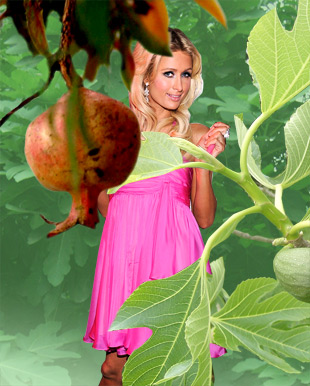Amy Levin: What’s the one holiday that Lurianic Kabbalists and quasi-pagan eco-Jews alike love celebrating? It’s Tu B’Shevat, aka, “The New Year for Trees.” The name Tu B’Shevat is derived from the Hebrew date of the holiday, the 15th of Shevat – “tu” stands for the Hebrew letter “tet” and “vav” whose numerical values, 9 and 6, add up to 15. “B” means “of” in Hebrew, and “Shevat” is the Hebrew month on which the holiday falls. Oh, and apparently it’s the Paris Hilton of Jewish Holidays.
Among the gamut of media sources paying homage to the green holiday, I like Rabbi Rachel Kobrin’s explanation of the roots of this tree celebration at HuffPost Religion:
During the time of the Temple in Jerusalem, Tu Bishvat was a day devoted to the very practical goal of declaring the age of trees for tithing purposes. In the 17th century, the kabbalists in Tzfat created a Tu Bishvat Seder. Modeled after the Passover Seder, this Tu Bishvat ritual was an effort to bring to life the verse from Deuteronomy 20:19: “For a person is like the tree of the field.” In celebration of fruit-bearing trees, throughout the seder participants eat various fruits that symbolize different aspects of themselves.
Participants begin by eating fruit with a hard shell, such as pomegranates, almonds and walnuts, thereby honoring our natural human need to protect our inner core. Participants then partake of fruits that have no outer shell, but do have a pit — such as olives, dates, plums and apricots. These fruits symbolize our inner soul, and the attention we must give to cultivating the spark of Divinity that lies at our core. Participants then eat fruit that has neither a shell nor a pit — such as grapes, figs, apples and carob. These fruits symbolize the human intellect, which the kabbalists envisioned as both open and unprotected. When we engage in intellectual discovery, we mirror God in continuing to create and build the world we have inherited. Through the act of eating significant fruits at the Tu Bishvat seder, the kabbalists believed we were releasing essential inner sparks of the Divine, and connecting in new ways with the spiritual realm.
Kobrin left out the best part of the seder–four cups of wine–but you get the gist. For me, Tu B’Shevat was always the kind of non-threatening holiday I could easily embrace guilt-free. But then of course, as Rabbi D. Sylvester reminds us, we should be shaming ourselves for this (click on the link for a daily dose of Israeli-Palestinian commentary on tree wars). Socio-political issues aside, many progressive Jews take this time to offer plugs for environmentalism and going green. Tablet Magazine even offers a “10 Inventive Ways to Celebrate Tu B’Shevat” from composting to reading The Pagan Rabbi. If you live in New York, you are Tu B’shvery lucky (ok not a good holiday for puns), because the city is your religious garden. Celebrate the holiday by checking out Central Park for musical and theatrical performances, the Manhattan Jewish Experience for fruits, music, and a lecture on forest restoration in Israel, a seder hosted by Pursue, Brooklyn Jews, and the Jewish Mediation Center that blends ecology, social justice, and mediation, or my pick, “Pinot and Pomegranate,” a night of live music, organic kosher wine, and delicious fruity desserts.
Jewish or not, the message(s) of Tu B’Shevat are clearly cross-cultural. But before we use the holiday to capitalize on the functionality of its inherent environmentalism, (and this may be the closest I ever get to exercising any theological power in my awkward positionality as an atheist, tree-hugging Jew) I say we offer the trees the respect they deserve. It’s one thing to worship trees, and another to use them to build our soap boxes.
Image credit: The Jewish Daily Forward

